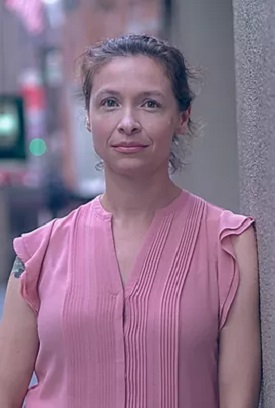 Synopsis:
Synopsis:
Private investigators Alice Vega and Max “Cap” Caplan, introduced to readers in Two Girls Down, return in The Janes.
On the outskirts of San Diego, the bodies of two young women are found. They have no IDs, no names . . . and no family looking for them.
The police and FBI fear they have discovered a human trafficking ring. They reach out to Alice Vega, a bounty-hunter-turned-private-investigator known for finding missing persons, to help them discover who the girls — dubbed the Janes — were, and who killed them. They also need help locating other missing girls.
Alice Vega is a powerful woman whose determination is matched only by her intellect. Along with Cap, she will stop at nothing to find the killer and uncover the truth before it is too late.
Review:

Author Louisa Luna introduced Alice Vega and Max “Cap” Caplan in Two Girls Down, the story of a struggling single mother who leaves her two young daughters alone in the car in a parking while she quickly runs into a store to make a last-minute purchase. When she returns to her vehicle, her daughters have vanished. Enter Vega, the mysterious bounty hunter hired by the mother’s parents to search for the girls when the local hapless local police prove inept. Vega’s past is murky and Cap, a former cop who left the force under a cloud of suspicion, now earns a living as a private investigator primarily chasing unfaithful spouses. Cap is a single parent, devoted to his teen-age daughter, Nell. Initially, their partnership is grudging — they tolerate each other solely because their singular efforts to find the missing girls are fortified by their combined resources and talent. However, their collaboration blossoms into a charming and touching relationship of trust with hints at romance.
The Janes opens with Vega visiting the County Medical Examiner’s office in San Diego where Mia Paiva, the stoutly eccentric coroner wearing a Deadpool T-shirt under her lab coat, shows her the bodies of two Latina girls. One is twelve to fourteen years of age and died as a result of multiple stab wounds. The other girl appears to have been a little older and also suffered stab wounds. Both girls bear other scars and commonalities, especially one key shared characteristic that catches Mia’s attention and jump-starts Vega’s investigation. In her rigored fingers, the second girl clutches a note bearing Vega’s name. The girl was clutching it so tightly that even the killer probably didn’t notice it. “I think she knew she was going to die and wanted to find you so that you could help the others,” Commander Otero tells Vega. “I think you could make this right.”
Vega is hired as a consultant for the Drug Enforcement Agency (DEA) to work cooperatively and share findings with that agency and the San Diego Police Department. It is believed that the two girls were being trafficked for prostitution and used as mules. Approximately a hundred thousand dollars’ worth of methamphetamine, cocaine, and marijuana is brought into the United States from Mexico through tunnels at the border. Vega immediately calls Cap, and asks him to come to California and work the case with her. Her timing is perfect. Cap is on the verge of accepting a full-time job as an investigator with a law firm. It provides steady income, benefits, and the thought of committing to it fills Cap with dread. Fortunately, his daughter urges him to join Vega and work the California case.
Luna’s approach to Vega, the complex, nuanced, fascinating, and empathetic character she has created and further develops in The Janes, provides insight. She notes that Vega can throw a punch, fights crime, knows some martial arts, and can handle firearms. But to call her a “badass” is to sell her short because in “female characters, the qualities of being a badass may have become too rote. Simply being a woman who can hold her own in a fight isn’t enough anymore to surprise us as readers, or even make us cheer along for a bit of the old cathartic feminist violence.” Vega is, rather, the kind of woman that men refer to as “difficult.” Indeed, she is relentless in her quest for answers, and quite ruthlessly devoted to the case. It’s personal — after all, she was brought into the case because a beautiful young woman was concealing a scrap of paper in her hand as she was murdered. Vega has an arsenal of tools at her disposal, including a pair of bolt cutters she puts to creative and efficient use, not to mention the keen intuition that causes her to question the motives of some of the members of law enforcement who are overseeing the investigation. Vega’s hunches are infallible, and she refuses to back down even when explicitly ordered to do so.
Cap is plainly enamored with Vega, as evidenced by his inner dialogue about her: “The elusive, the conundrum, the deviously lovely.” Luna capitalizes on the romantic tension between her characters with a “will they or won’t they?” undercurrent to their good-natured, teasing banter. Cap respects Vega’s intellect and ingenuity, even though he often questions her methodology. Their opposite styles and approaches to their work complement each other. Vega “had a tendency to announce what she was thinking only when it was fully formed, the opposite of what Cap had been used to as a cop, pitching whatever waltzed into his head. Even if it didn’t bear out in the end, he gave it words and a shape, and sometimes it fit.” The two have established a partnership of trust, confidence, and deep care for each other that carries them through the risky maneuvers Cap goes along with, and numerous close calls as they encounter a number of characters who will employ any means necessary to keep them from uncovering the truth.
That The Janes is cleverly and thoroughly plotted becomes apparent as Luna details the investigative steps Vega and Cap take, painstakingly following leads and analyzing clues that lead them closer to the truth. The intricacies of the criminal enterprise Luna depicts are plausible and horrifyingly believable. Vega and Cap uncover a darkly complex operation of drug smuggling, human trafficking, sexual assault, kidnapping, and murder, at the center of which are a group of innocent teenage girls. Vega tenaciously puts her own life in danger, as well as Cap’s, to ensure they don’t meet the same fate as the two Janes.
The tempo of The Janes never slackens and, in fact, accelerates as unexpected allies join Vega and Cap in their quest to see justice done for the Janes, the other girls, and their families. The ripped-from-the-headlines story is timely, engrossing, and made more entertaining because Vega and Cap are thoroughly likable and empathetic. Through judicious attention to plot, an eclectic cast of characters, and her characters’ relationships, Luna guarantees that readers will root for the success of their mission . . . and eagerly anticipate their next adventure.
Also by Louisa Luna:
Excerpt from The Janes
1
meet our girl: seventeen, arrived here a year ago from a rough and dusty town in Chiapas, considered pretty by most standards because she is young, her face unmarked by scars or wrinkles, her body boasting the tender snap of fresh muscle. Our girl’s brain, on the other hand, is at war with itself and others: with memories of her mother’s worry and her father’s pain, subtle with her own simmering meditations on sex and violence, with fear of all the men that come through the door with their eyes so stark and full of want it’s like they’ve eaten her up before they’ve even selected her from underneath the butcher’s glass.
Our girl walks in bare feet, unsure if she is dreaming. Her dreams these days are collisions, collages, bursts of fire and color that all start normally enough—she is playing paper dolls with her sister on the porch under the umbrella with one panel missing, or fluffing up yellow rice in a pot right after it’s done steaming. But then they turn; the dolls become scuttling cockroaches in her hands; the rice bowl fills with blood; her own teeth grow into blades and shred her tongue to streamers.
The house is divided, two floors: the ground floor, where she and the other girls sleep on towels side by side in the bedroom they share, and watch TV and wait in the living room; and there’s downstairs full of boxes that pass for rooms—no windows, no air. The working rooms.
Then there is the garage, which is separate from the house, but there are no cars inside. There is just a table and some machines and tools. Our girl hasn’t been there yet but this is what she’s heard. Only girls who cry and act stupid are taken there and our girl keeps her head down and does what she’s supposed to do. She doesn’t ask questions and doesn’t make trouble, but she watches everything.
She avoids the bosses. Coyote Ben is easy to avoid because he comes and goes, although when he’s around and there’s no work he grabs the hair at the back of her neck and whispers in her ear. He speaks English so she doesn’t really understand everything he says, but she knows he doesn’t expect her to respond. He lets her make the drinks.
Fat Mitch is always there, and he’s got the gun on a belt that looks like it’s strangling all the fat on his stomach. He has named the gun, Selena, after a singer, and he is always reminding the girls the gun is there. He’ll say things in Spanish like “Selena got a lot of sleep last night and wants to have some playtime today.” And then there’s Rafa.
Rafa is the one who takes the girls to the garage. Fat Mitch tells them Rafa only does what he does because he has to, but our girl doesn’t buy it. She knows Rafa does it because he likes it. It’s not like on a farm when they make the runtiest worker shoot and drown the sick animals to toughen him up. The house may be a farm but Rafa’s no runt—he’s bigger and stronger than Fat Mitch, and our girl has heard he smiles when he does what he does to the girls in the garage. That is what they get when they act stupid.
Our girl’s not stupid, and she stays away from the stupid girls: Isabel, Chicago, Good Hair. They cry and try to steal food. Stupid. The girl called Maricel is new, one of the girls from the city, and while it’s usually not a good idea to get to know the new girls, our girl actually likes her and Good Hair both. In another time and place they may have all played card games and shared secrets about boys in their class. Instead they wait to be picked. Which is better than the alternative. If a girl doesn’t get picked from the TV room for a month, she’s out, not taken to the garage—out out, out of the house and dropped somewhere in the desert because she’s not worth the Wonder bread.
Our girl has learned a little English here and there from TV. She pays attention to the American news. Police, homicide, catch, release. She watches a news show about a boy who looks her age, and Mexican too, but American. She tries to wrap her mouth around a word the newswoman keeps repeating, which sounds like something about a duck flying up. Duck-ted. Up-duck-ted. The boy talks to the newswoman, points to a picture of a fish tank. Then there is another woman, not the newswoman; 2014 it says in the corner. Her name is at the bottom of the screen. Our girl notices: American first name, Mexican last name. She looks like she is police. Or a lesbian. Or a gangster. She wears black clothes and sunglasses.
Back to the boy. Over and over he says the same thing: “She safes me, she safes me.” Our girl watches the boy’s top row of teeth, the way they scrape his bottom lip as he cries. The word is not “safes.” It’s “saved.” “She saved me,” the boy says, again and again.
Our girl watches Maricel get up close to the TV. Maricel doesn’t take her eyes off it. The boy on the screen says, “She saved me. Alice Vega, she saved me.” Maricel begins to cry, along with the boy. Our girl watches her and realizes her own hands are shaking.
Our girl has a thought out of nowhere: you treat us like dogs; we’re going to act like dogs. A map unfolds in her mind, square by square. She saved me, the boy says. She saved me.
Excerpted from The Janes by Louisa Luna. Copyright © 2020 by Louisa Luna. Excerpted by permission of Doubleday Books. All rights reserved.
Enter to Win a Copy of The Janes
NOTE: The book may only be mailed to a United States address.




6 Comments
Captivating and thrilling story which interests me greatly.
I have not read “Two Girls Down”. “The Janes” sounds like a captivating story and a real page turner.
I have not read “Two Girls Down” yet, but I just added it and “The Janes” to my TBR list. I love these kind of thriller/mystery type books because they always draw me in and keep me on the edge of my seat. I love the idea of a female PI being the one that gets the answers and saves the day! Thanks for introducing me to another new-to-me author that I think will become a favorite!
thriller which sounds good
I’m interested in reading this as it sounds like an excellent thriller; the issues of kidnapping and drug cartels are integral to this story and I’m already curious as to how this links to the murdered girls.
I haven’t read this, but it sounds really good. I love thrillers and books set in the San Diego area.